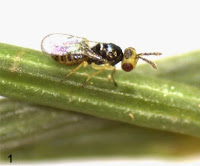The Bermudagrass Stem Maggot, Atherigona reversura, is the larvae of a Muscid Fly (House Fly) which burrows into the shoots of young Grass plants, killing or damaging the plant. It's favoured food is Bermudagrass, Cynodon dactylon, (which doesn't actually come from Bermuda), but it will feed on many species of Grass, and is considered a serious agricultural pest in pastureland in tropical and subtropical areas. The Maggot is native to Burma, China, India, Indonesia, Malaysia, the Philippines, Sri Lanka, and Taiwan, but has been introduced to a number of other areas, including Hawaii, Papua New Guinea, Japan, Oman, the continental United States, and Mexico.
Bermudagrass Stem Maggot identified in a Florida Bermudagrass hay field. Liza Garcia-Jimenez/University of Florida.
In a paper published in the journal Check List on 15 July 2016, Luciano Patitucci of the Museo Argentino de Ciencias Naturales “Bernardino Rivadavia”, Matías Dufek of Biología de los Artrópodos at the Universidad Nacional del Nordeste, and Pablo Mulieri, also of the Museo Argentino de Ciencias Naturales “Bernardino Rivadavia”, report the first known occurances of the Bermudagrass Stem Maggot in South America.
Adult specimens of Atherigona reversura were discovered during a survey of Flies in the Oriental Chaco and Pampas Grasslands ecoregions. The presence of the Fly was established in three provinces, Buenos Aires, Chaco, and Santa Fe. Given the wide range established for the Fly in Argentina, and the variety of ecosystems in which is was found, as well as the widespread growth of Bermudagrass as a fodder crop in South America, Patitucci et al. consider establishing the full range of the Fly in South America a matter of some urgency, and recommend further surveys in other areas of Argentina, as well as areas of Brazil, Paraguay and Uruguay with similar climates.
Male of Atherigona reversura, lateral view. Pablo Mulieri in Patitucci et al. (2016).
See also...
 Western Flower Thrips reported in India. Thrips (the word is both singular and plural),Thripidae, are very
small Insects with wings reduced to feathery growths (though this is sufficient
to support them in flying due to their small size). They feed by sucking fluids
from plants, and as such are...
Western Flower Thrips reported in India. Thrips (the word is both singular and plural),Thripidae, are very
small Insects with wings reduced to feathery growths (though this is sufficient
to support them in flying due to their small size). They feed by sucking fluids
from plants, and as such are... Tripius gyraloura, a Sphaerularid Nematode infecting the Arundo Gall Midge. Sphaerularid Nematodes are highly virulent parasites
of Insect hosts. While most parasites seek to keep their host alive for
as long
as possible, enabling them to live and produce offspring for as long as
possible, Sphaerularids begging to reproduce at a high...
Tripius gyraloura, a Sphaerularid Nematode infecting the Arundo Gall Midge. Sphaerularid Nematodes are highly virulent parasites
of Insect hosts. While most parasites seek to keep their host alive for
as long
as possible, enabling them to live and produce offspring for as long as
possible, Sphaerularids begging to reproduce at a high... Two new species of Ironwood infesting Gall Wasps from Micronesia and Australia. Ironwood Trees of the genus Casuarinaare native to Australia, Southeast Asia, South America and the islands of the
western Pacific. They are widely grown for their timber, as well as for
windbreaks and for their ability to stabilize soils in erosion-prone areas...
Two new species of Ironwood infesting Gall Wasps from Micronesia and Australia. Ironwood Trees of the genus Casuarinaare native to Australia, Southeast Asia, South America and the islands of the
western Pacific. They are widely grown for their timber, as well as for
windbreaks and for their ability to stabilize soils in erosion-prone areas...
Follow Sciency Thoughts on
Facebook.


